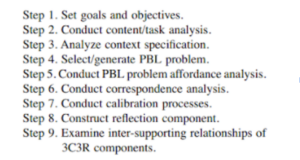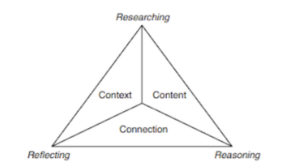< Previous Section (About the FYS)
FYS as a Promising Solution:
Sustainability Education and Project Based Learning:
Solar! An Array of Energy and Education is a distinctive college course, utilizing meaningful local examples to facilitate course material for stronger long term retention for students. Historically, undergraduate institutions are often reluctant to reform or adjust curriculum. Engineering institutions that work to maintain and excel their prestige and academic excellence are no exception. UCLA, Caltech, Harvey Mudd, and MIT are examples of undergraduate engineering institutions that have experienced significant social and political pressures to reform their technical curriculum, particularly in the 1960s. For instance, UCLA’s Education Development Program (EDP) helped to shift the undergraduate postwar technical engineering curriculum to move towards a curriculum that integrated applied humanities.
Even so, changes did not start until after twelve years of the EDP’s extensive evaluating, reporting, and documenting of UCLA’s engineering program. Caltech is an institution that is not geographically far from UCLA. However, Caltech failed to expand to the degree of UCLA during the 1960s. Part of this can be attributed to the lack of humanities at Caltech. During the backlash of technology, students argued the school’s strict technical curriculum created an “alienating culture.” In an attempt to make the school more human, Caltech instituted social sciences which lead to experts in technological society as opposed to a more humanities-based curriculum like that at UCLA. Wisnioski writes “the debate over integrating social knowledge into engineering education thus became a debate between the humanities and the social sciences. Social scientists saw Caltech as uniquely poised to create expert policymakers for a technological society.” Conversely, Harvey Mudd College (HMC) opened with the sole mission to integrate engineering with the humanities and social sciences. HMC was also the first college to introduce interdisciplinary coursework. Quest was a HMC first year program that had a goal for students to understand that “the political, legal and social problems that men had dealt with was as important as suggesting a solution to them.” (Wisnioski, 2012, 161-185)
Yet, even when colleges creatively implement non-traditional curriculum, there are challenges that come with it. 1973 was the last year of HMC’s Quest because faculty felt “overtaxed” and missed the comforts of research, essentials of tenure, and “disciplinary identity.” MIT faced urgency for curriculum change from the social pressures of the student body. Students and leftist faculty protested and worked for more social science and humanities courses. Faced with these pressures at that time, the President of MIT commissioned Creative Renewal in a Time of Crisis in order to better understand the culture at MIT in order to implement curriculum change within MIT’s departments. The political and social pressures exhibited at UCLA, Caltech, HMC, and MIT assist in directing and reforming engineering curriculum. The efforts of these pressures is observed in our very own unique degree at Lafayette College, Engineering Studies. Yet, even so, the challenges of curriculum change at higher education institutions is not trivial, leading often to resistance. (Wisnioski, 2012, 161-185)
Education reform at an undergraduate level faces high levels of both social and political pressures that help to shape and direct educational trends. High schools have more room to creatively explore new avenues for education facilitation. Project Based Learning (PBL) is an example of an education movement that caught on in k-12 schools around the country. According to the Buck Institute for Education, “Project Based Learning (PBL) is a teaching method in which students learn by actively engaging in real-world and personally meaningful projects” (Buck Institute for Education, n.d.). More so, PBL as a teaching method aims for students to “gain knowledge and skills by working for an extended period of time to investigate and respond to an authentic, engaging, and complex question, problem, or challenge.” (Buck Institute for Education, n.d.)
This teaching method first started off in Canada during the 1950s within the context of purely medical education. PBL started to infiltrate the United States during the 1980s and by the 1990s had been applied beyond medical education to higher education and k-12. PBL is particularly popular in graduate level curriculum for business administration, architecture, law school, education, nursing, and social work. While graduate courses often are able to implement PBL, there is still a lack of PBL at an undergraduate level. A benefit of PBL education is its flexibility to be applied within a variety of ability types, ages, and geographic contexts. More so, retention after six months is proven to be six times more effective in PBL methods than traditional methods. (Hung et al., 2008) . Barrows and Kelson developed the PBL curriculum for high school core subjects in 1993 and started a movement of scholars supporting PBL for basic education. Increasing PBL literature reviews and conferences are a testament to the growing popularity of PBL in K-12 education (Hung et al., 2008).

Figure 7: “Breakdown of PBL Methodology” (Hung et al., 2008)

Figure 8: “PBL Design Model” (Hung et al., 2008)
Solar arrays are used to facilitate PBL and meaningful non-traditional education, particularly within the context of K-12 students. Rutland High School in Vermont utilized solar arrays to help students better understand solar array data sets and explore questions relating to climate and engineering. This example of PBL learning is extremely data driven. Similar to the EGRS curriculum at Lafayette College, the students at Rutland High School integrated society, engineering, climate change, and power systems through real world data collected by the arrays. Betts argues that “society makes major changes in our energy infrastructure in response to climate change. We need to accelerate the technical education of high school students using real-world data.” This learning outcome through meaningful education helps reach beyond the classroom to the broader public and aides in the ongoing push to rely more on alternative energy. Education can be a valuable tool to implement solar energy and broader solar infrastructure on a local, national, and global scale, especially when utilizing real world examples like the Kirby Solar Array. (Betts, 2008)
Solar arrays are implemented on college campuses to offset their carbon emission. Arizona State and Ohio state are two examples of this. Yet, solar arrays can be utilized for more than just an alternative energy source. The Kirby Solar Array is a wonderful opportunity to implement PBL within the context of higher education as Lafayette moves to more non-traditional ways of teaching facilitation. Astronomy, Project Management, and Conservation Biology are examples of courses that utilize local spaces to facilitate education in a non-traditional way. Lafarm is an example of Lafayette’s very own facility that is used as an interactive education resource for students that is utilized both co-curricularly and within the Lafayette curriculum. (Lafayette College, n.d.) (Goldfarb, 2016)
Growth, Sustainability Education, and Community:
Engineering Studies is a unique interdisciplinary major where students study the relationship between engineering, technology, and society. Because it’s a small division under the engineering department, many students and faculty are unaware of the methodology and value of the major. Exposure to Engineering Studies as a mechanism is valuable for any student at a liberal arts college. Adding an FYS under the Engineering Studies division allows for growth in two ways. Firstly, an FYS under the Engineering Studies division allows for more students to be aware of the department for a potential major. Secondly, the students of the first year seminar, per the learning outcomes, are required to learn how to apply a socio-technical lens. This application is relevant to every department at Lafayette College, thus the value of methodology is not limited to students within the major. The implementation of the FYS offers the Engineering Studies department an opportunity to increase its presence on campus whether that means expanding the methodology to students outside the EGRS major or literally growing the number of students who major in Engineering Studies at Lafayette College.
Just like this first year seminar offers the opportunity for the Engineering Studies Department to grow its influence at Lafayette College, it also offers the opportunity for solar energy to grow its influence in the nation. Because of the United States’ dependency on fossil fuels, Scholars argue that for the United States to transition to more renewable energy, particularly, solar energy, the United States must prioritize and value renewable energy education. This education is valuable at any age and learning ability, however, is particularly influential for early elementary education. This first year seminar expands Lafayette’s curriculum by supplementing its sustainability curriculum to include another class while also extending sustainability curriculum to age groups outside of higher education. (Yogi Goswami, 2001)
Ultimately, this first year seminar is community centered. By extending solar array education to elementary and middle school students in the Easton area, Lafayette is also extending facilities to the Easton Public School District that they would otherwise not have access to for learning opportunities. More so, by having Lafayette students create meaningful lessons for students outside of higher education, the college instills community as a value during the students’ very first semester at Lafayette College.